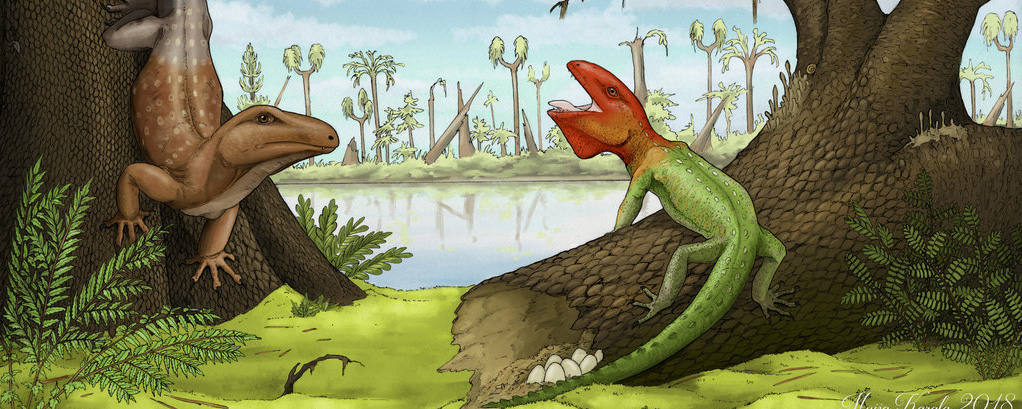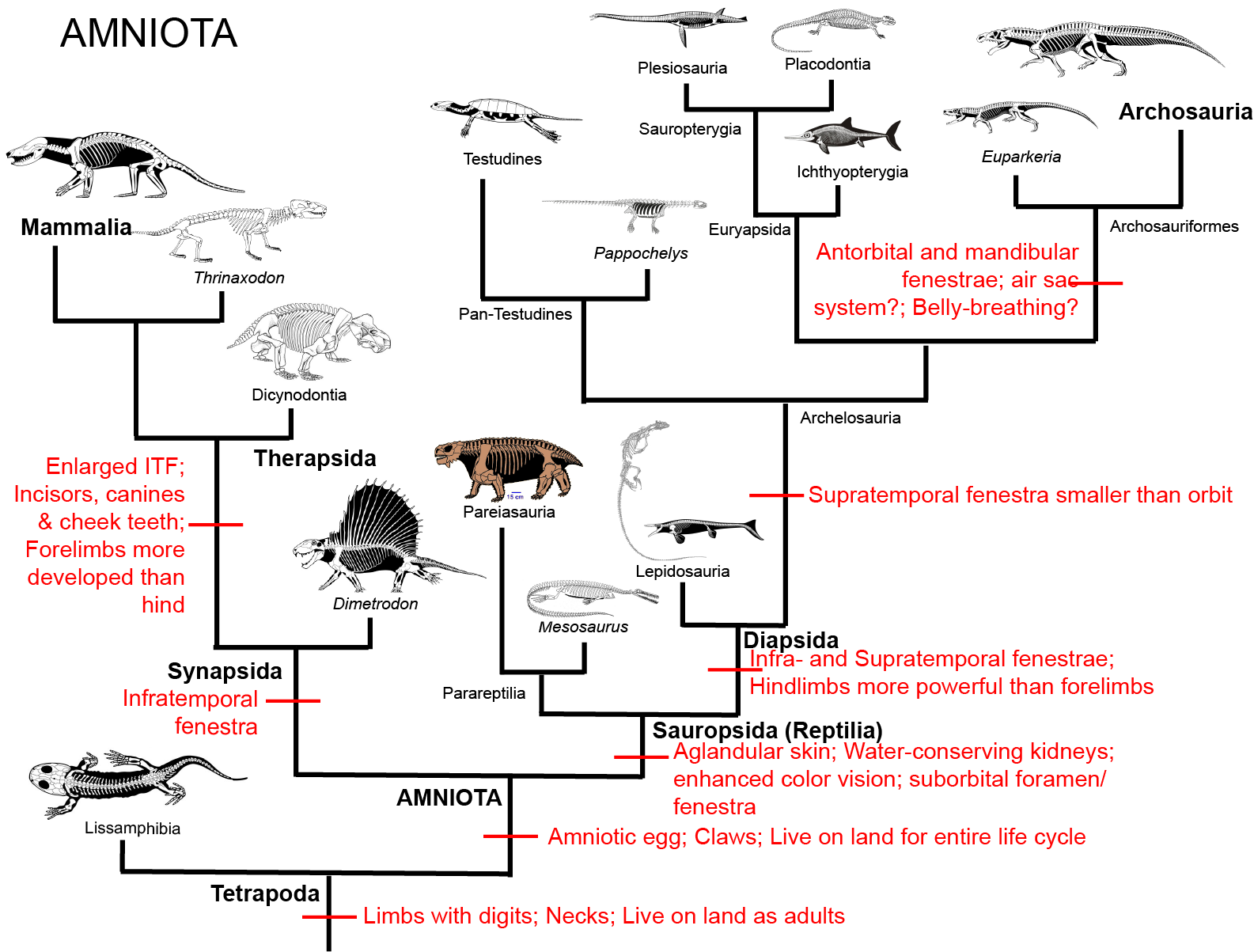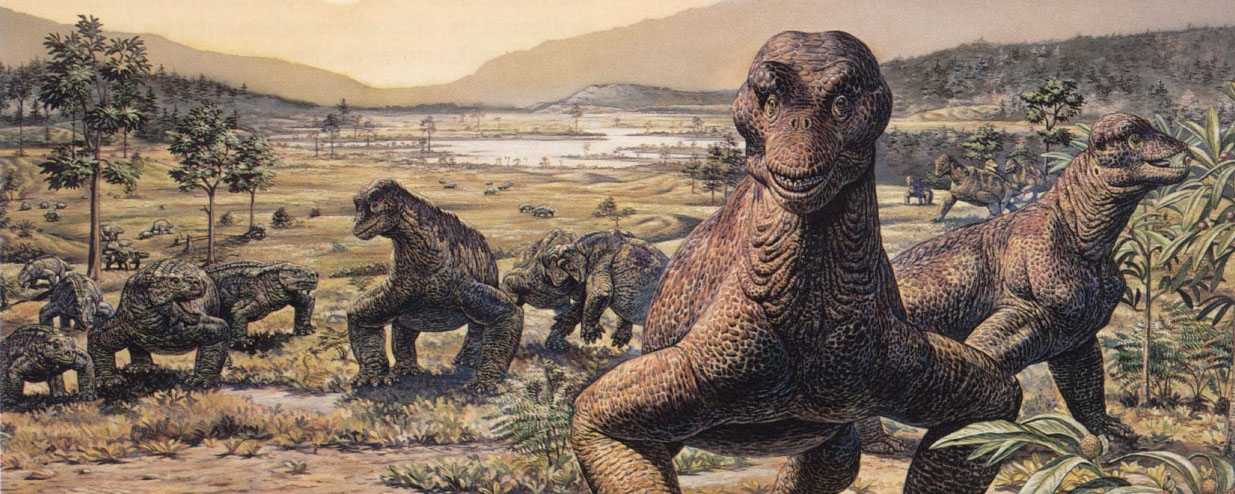Which Of These Helped Animals Colonize Land?

GEOL 104 Dinosaurs: A Natural History
Fall Semester 2021
Eggs Conquer the Land: Amniote Life Earlier the Dinosaurs
Primal Points:
•Life emerged in the h2o, and it took a serial of adaptations (defense against gravity and desiccation; new forms of respiration, reproduction, locomotion, and senses; etc.) for taxa to colonize the country.
•Among vertebrates, information technology was "amphibian"-grade tetrapods which partially fabricated the transition to life on land, simply only the amniotes that lived their entire life bike on land.
•The amniotes had evolved a shelled egg, keratinized skin, and claws (among other traits) which allowed them to be successful at living on country.
•Unlike groups of amniotes radiated at unlike times: the starting time group were the basal members of the Synapsida (the lineage that contains mammals) in the Carboniferous and Early Permian; followed by their descendants (the Therapsida) in the Middle and Late Permian.
I. The Colonization of Land
Life on Earth first evolved in the seas over 3.5 billion years ago, and even today the majority of living things are aquatic. The terrestrial realm of land and air offers many challenges to organisms adjusted to aquatic life:
- Gravity: aquatic life is buoyed by water. Air is not and so buoyant! And then terrestrial animals have to accept some sort of supporting tissue.
- Desiccation: air is drier than water (duh!!), so terrestrial organisms need some form of pare or coat to keep all their precious bodily fluids from leaking out.
- Respiration: aquatic organisms exchange oxygen and carbon dioxide dissolved in water. In air, these substances are gases, so new structures are needed to breath.
- Reproduction: aquatic organisms oftentimes release their eggs, sperm, etc., straight into the water. This approach is much less constructive in air, so other solutions evolve.
- Locomotion: aquatic animals can swim, scuttle, squidge, or otherwise move through the water. These motions have to exist modified in the terrestrial realm.
- Senses: light, audio, and smell transmit differently in h2o than in air, and some senses (such as the pressure level sense and electrical sense) don't work in air at all. Terrestrial animals take to evolve new adaptations to deal with these differences.
The starting time organisms that spent at least quondam out of water were algae mats along the edges of seas and lakes (which are amidst the oldest fossils known!) But for over iii billion years life was essentially limited to the water. By the early on Paleozoic Era, the marine realm was equally crowded with living things as the modernistic oceans, only the land was still more often than not barren: peradventure some lichens and bacteria, but not much more.
Among the get-go fully terrestrial organisms were true primitive plants that had colonized land by the Silurian Flow (443.4-419.two Ma). (Some fossils bear witness that they actually had colonized at least by the before Ordovician Menstruation, but were evidently not widespread.) The terrestrial world offered the primitive plants mineral resources and plenty of more infinite (to collect sunlight!) than could be found in the crowded seas.
The first terrestrial animals were various types of arthropods (bugs, broadly defined): the ancestors of millipedes and centipedes, the earliest arachnids, and the ancestors of insects were established on land in the Silurian Period. These ate the early plants, and each other.
(Other groups, such every bit earthworms, other worms, snails, and then on colonized during this fourth dimension.)
The ancestors of the dinosaurs (and united states!) during this time were notwithstanding entirely aquatic. Primitive vertebrates were all aquatic: in other words, they were fish. ("Fish" is just the name for all vertebrates that aren't tetrapods; at that place are many various lineages of vertebrates other than the land ones!).
In the early on part of the Devonian Catamenia (419.2-358.9 Ma), the fish continued to diversify. This diversity included many sorts that lived in freshwater.
Freshwater has its own problems compared to body of water water, only various types of fish evolved traits to deal with them:
- In lakes, ponds, and swamps the oxygen frequently gets used upwards, so fish evolved a lung to gulp air. Various types of modern fish (including a group called "lungfish") still apply these lungs to gulp air to breath; in others information technology has evolved into a swim bladder.
- Freshwater systems tin oft get high-strung with logs, weeds, and so along, and so ane group of fish (the Sarcopterygii, or lobefins) evolved a series of basic down their fins to give them force to push button along, dig, etc.
- Freshwater bodies are far more probable to dry out up than the oceans (duh!), so fish evolved ways to bargain with those situations. Some burrowed into the mud and waited for the wet flavor, only others moved from one stale upwardly pond to another (hopefully less dried up) one. Today there are several sorts of fish that withal do this: mudskippers, some eels, some catfish, the snakeheads, etc.
- In the Devonian one branch of lobefins, the stegocephalians, evolved wrists to give them actress "push" and digits (that is, fingers and toes) to give them better buy.
- Ponds, lakes, and streams can get starved of food resources more hands than the sea, so many freshwater fish capture food from the shores. Devonian stegocephalians may take crawled onto shore to capture nutrient, merely as mudskippers and snakeheads do today.
So by the subsequently part of the Devonian Period there were vertebrates which had a bony skeleton to support their bodies; bony limbs with wrists, ankles, and digits to push forth on land or on the lakebed; lungs to breath air (merely still had gills to jiff in the water).
- Notation that these are all exaptations: they evolved in some other context, but allowed the stegocephalians to motion around on land.
Many of these Late Devonian stegocephalians still lived their lives substantially only in the h2o (such as Acanthostega), and thus were essentially fish-with-fingers. Others (such as Ichthyostega) may take gotten most of their nutrient from country. It was from these latter sort that the more than fully terrestrial vertebrates--the Tetrapoda ("four footed ones"), would evolve.
During the early part of the Carboniferous Menses (358.9-298.9 Ma) the early on tetrapods became established. Dissimilar earlier stegocephalians, these had necks (that is, the skull was non fastened to the scapula), which allowed them to bend their heads down to capture food on land. Like fish, these early tetrapods notwithstanding laid their eggs in the h2o and their young (tadpoles) often had gills. Every bit adults, though, many were more than terrestrial.
In that way, the early tetrapods were "amphibians" in the broad sense of the term. Yet, these were ofttimes scaly-skinned (similar fish), unlike the naked-skinned Lissamphibia (frogs, toads, salamanders, etc.: the modern clade of amphibians). Carboniferous and Permian (299-251 Ma) Period primitive tetrapods included a cracking diversity: snake-similar forms; primarily aquatic boomerang heads; alligator-like forms; and many others. Just even for those forms which spent most of their developed lives on land had to come back to the freshwater to reproduce.
During the Carboniferous, however, one grouping of tetrapods evolved an adaptation that allowed them to break free of the pond: the amniotic egg. Instead of being a "naked" egg laid in a pond or stream, the amniotic egg had:
- A shell to prevent desiccation (ancestrally information technology is a leathery, parchment like shell; in some derived forms it is calcified and "crispy")
- A cocky-contained "pond" (the amnion) in which the embryo grew
- Tissues to bargain with gas exchange and waste matter
In other words, tetrapods were at present freed from the water. Every bit such, the tetrapods with an amniotic egg did not have a larval ("tadpole") phase, and so they were terrestrial for their entire life cycle. This adaptation marks the evolution of the most successful clade of tetrapod, the Amniota:

Other than the amniotic egg, amniotes are likewise characterized by claws. (Well, and a agglomeration of other traits, besides, merely nosotros are not going into that level of item in this 100-level class!)
2. Life on Land Before the Dinosaurs
Amniotes first appear in the later Carboniferous Flow. At this time, many low-lying parts of the land were covered in vast coal swamps (so called because the buried remains of these swamps make upwards the majority of the coal deposits of the Northern Hemisphere). While the fish-eating tetrapods stayed near the ponds, the amniotes were free to pursue other prey further onto land. With admission to this new environment, the amniotes underwent a series of adaptive radiations.
Amniotes carve up into 2 major divisions:
- Synapsida, represented today only by mammals
- Sauropsida ("Reptilia" to some), represented today by turtles, lepidosaurs (lizards [including snakes] and tuataras), crocodylians, and birds
The synapsids were the kickoff grouping to radiate. Synapsids are characterized past a skull with a complete infratemporal fenestra with a lowerbar only no supratemporal fenestra.
During the Early Permian Epoch primitive synapsids radiated into many different forms, including:
- Caseaidae, Pocket-sized-headed, heavily-built herbivores
- Ophiacodontidae, Semi-aquatic fish-eaters
- Edaphosauridae, Sail-backed herbivores
- Sphenacodontidae, Sail-backed carnivores with different-sized teeth in different parts of the jaw
- The sails of these latter 2 may have been used to grab sunlight allowing them to warm upwards faster than other animals and/or equally display structures
- The different-sized teeth of the latter immune more specialization of food processing: a trait passed onto afterward synapsids
These early on synapsids would accept had the sprawling stance establish in primitive tetrapods in general. They almost certainly would take been "common cold-blooded" (the ancestral state for vertebrates). So traditionally these animals have been considered "reptiles". However, they lack the shared derived features of reptiles (run into below), and are instead simply primitive synapsids. (In traditional taxonomy, these were put in the group "Pelycosauria", but this is a paraphyletic group: all synapsids except for therapsids). New discoveries show that even early synapsids had some parental care.
The early synapsids evolved themselves into extinction: that is, they were replaced in the Middle and Late Permian Epoch by the Therapsida: the advanced synapsids. Once called the "mammal-similar reptiles", they are non true reptiles. Instead, they are the advanced branch of the synapsid phylogeny. They differed from earlier synapsids by:
- Greatly expanded infratemporal fenestra
- Teeth divided into nipping incisors, biting canines, and grinding cheek teeth
- Forelimbs more powefully developed than hindlimbs
The Middle and Belatedly Permian therapsids included:
- Dinocephalia, Large slow-moving herbivores and carnivores of the Heart Permian
- Gorgonopsia, the apex predators of the Late Permian
- Dicynodontia, the extraordinarily successful beaked, 2-tusked burrowing omnivores and herbivores (which would persist well into the Triassic)
- and the oldest Cynodontia, initially smaller specialized carnivores and omnivores which eventually produced the mammals.
Ancestrally, all vertebrates are cold-blooded (warm their bodies primarily using sunlight). However, some bear witness suggests that the avant-garde therapsids of the Late Permian may have had elevated metabolisms (that is, were at least partially warm-blooded):
- Some had a more upright stance than typically sprawling tetrapods
- Some may have had a diaphragm, allowing more effective breathing (more in the tertiary office of the course)
- Similarly, some had a secondary palate, allowing them to breath while bitter/feeding
- Additionally, the complex cheek teeth of near therapsids allowed them to grind food upwards more effectively
Additionally, some therapsids seem to accept had parental care of the immature, keeping them in burrows.
Sauropsids tended to be relatively rare in the Carboniferous and Permian Periods. Sauropsida is characterized by a number of particular skeletal features (which we aren't going to deal with here, every bit they are fairly technical). Modern sauropsids (and past inference, their concestor and all of its descendants) share a number of soft-tissue features:
- Aglandular pare: peel of fish, lissamphibians, and mammals have numerous glands (mucous, sweat, etc.). Sauropsid skin has few glands.
- "Waterproof" pare: sauropsid skin has a special form of keratin that makes it relatively stronger and less likely to lose wet than in other amniotes.
- Water conserving kidneys: waste released as uric acid instead of urea (although turtles still primarily use urea)
- Excellent color vision: four-to-v type of color receptors, as opposed to the three of humans and many other primates and two in most placental mammals. (Once thought to exist a shared derived feature of Sauropsida, but may simply be retained from the ancestral amniote: nosotros'll see more when we await at the origin of mammals)
- And, to list ane skeletal feature that is actually preservable in the fossil tape, a suborbital foramen or fenestra ("So. f" in this figure; an extra opening on the palate of the skull
Parareptilia is a major clade of basal sauropsids which flourished aslope the synapsids during the Permian, only became rarer in the Triassic. The well-nigh archaic of these groups (the aquatic Mesosauridae) was thought (from 2012 to 2014!) to have an infratemporal fesestra, but this appears to be a mistake. Most other basal parareptiles have the no-fenestra (anapsid) condition, although a few derived ones have a fenestra (lacking the lower bar): traditionally this is thought of as independently derived from synapsids and diapsids, but at least ane contempo analysis found parareptiles INSIDE Diapsida! Because well-nigh parareptiles had the anapsid condition, they were traditionally called "Anapsida", but now called "Parareptilia" (or by some "Proganosauria"). Parareptiles underwent a radiation in the Permian, producing:
- Mesosauridae, web-footed needle-toothed swimmers
- Procolophonia, a clade of squat insectivores, carnivores, and herbivores which really survive until the end of the Triassic
- Bolosauridae, Long-legged, lizard-similar runners
- Pareiasauria, badger-to-ox-sized, squat, armored herbivores that were among the few successful sorts of sauropsids in the Permian
- And a few other forms.
For many years it was argued that turtles were a co-operative of parareptile. And it is true that the oldest known animals more closely related to turtles than any other named group is a wide-bodied Permian form with broad ribs. New discoveries of this animal (Eunotosaurus) and of Triassic proto-turtles testify that the turtle lineage is a type of diapsid, still, and not parareptiles at all.
Other primitive Carboniferous and Permian sauropsids show the anapsid condition, but were eureptiles (the clade containing diapsids [see below] and their closest relatives).
Relatively rare during this fourth dimension are the oldest known members of Diapsida. This would eventually evolve into the major clade of eureptiles, and the dominant clade of amniotes during the Mesozoic. Changes from the ancestral sauropsid condition to Diapsida include:
- The diapsid skull condition, with both infratemporal and supratemporal fenestrae giving a fast and powerful bite
- Hindlimbs longer and more powerful than forelimbs, assuasive them to shift from quadrupedal to bipedal mode when speed is needed:
- In diapsids, the muscles running from the femur to the tail are the main ones to provide thrust; consequently, diapsids tend to have big muscular tails
During the belatedly Paleozoic diapsids were only a very modest office of the ecosystem.
In general, compared to typical Mesozoic and Cenozoic ecosystems, the late Paleozoic land vertebrates were smaller (few ox- or hippo-sized, none larger), slower (no real speed specialists), and close to the ground (only a few gliders and no powered fliers; few tree-climbing specialists).
A relevant video:
To Side by side Lecture.
To Previous Lecture.
To Lecture Schedule.
Last modified: 1 July 2021

Source: https://www.geol.umd.edu/~tholtz/G104/lectures/104land.html
Posted by: gonzalezesifer88.blogspot.com

0 Response to "Which Of These Helped Animals Colonize Land?"
Post a Comment